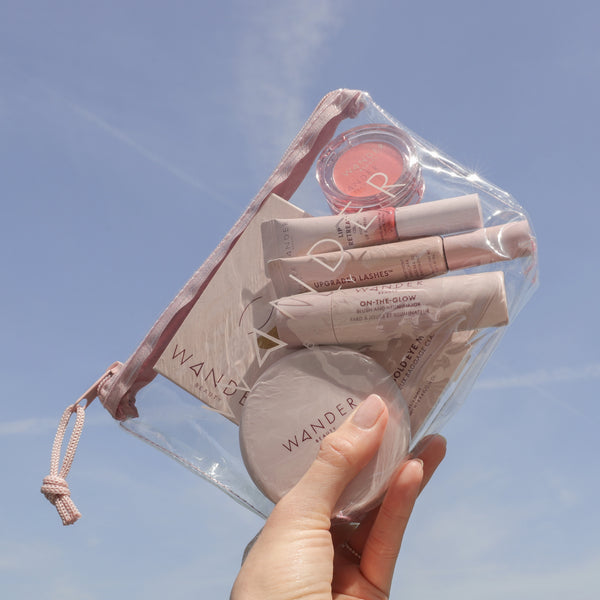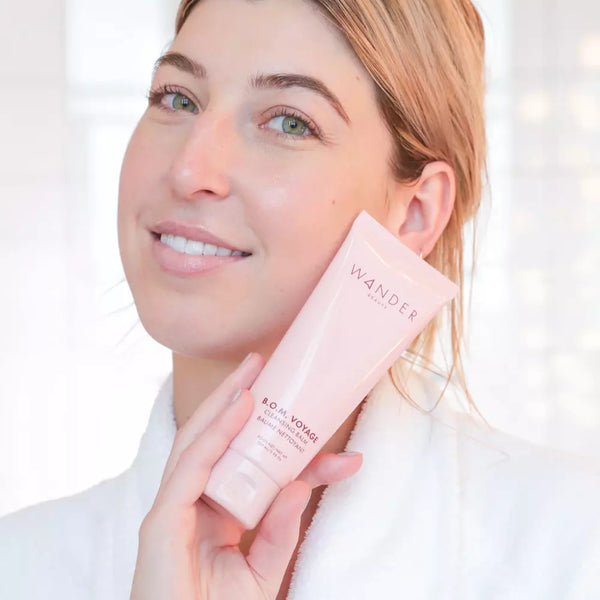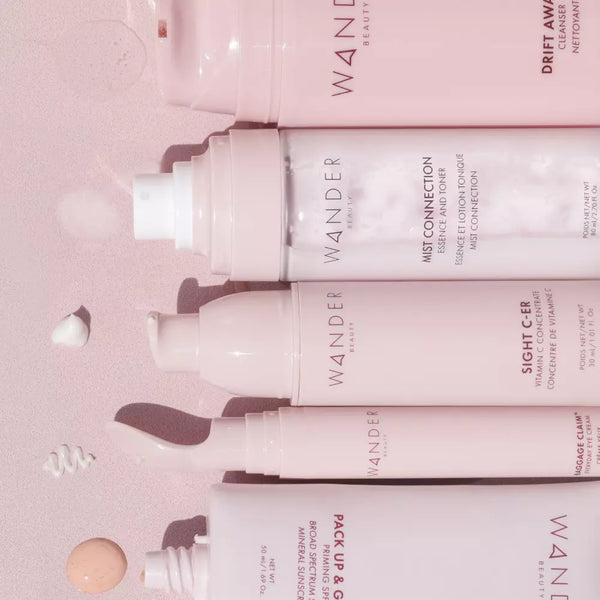How Often Should You Clean Your Makeup Tools?
By Wander Beauty | Jul 18, 2022
We all know the importance of washing your face and brushing your teeth twice a day, but many of us aren't as aware of the necessity of regularly cleaning our makeup brushes. You may be surprised to know that washing your application tools every month and replacing them every few months is simply not sufficient.
So how often should you clean your brushes, what should you clean them with, and what is the best way to clean them? Read on as we answer these questions to keep your skin and makeup tools fresh and healthy.
Why you need to clean your makeup tools regularly
Regularly cleaning your makeup tools is as essential to your skincare routine as washing your face every day. Natural oils, dead skin cells, dirt, and bacteria accumulate on makeup tools and are reapplied to the skin with every use. This can lead to skin issues like acne, skin sensitivity, contact dermatitis, and infections. Furthermore, cakey, oil-filled brushes and sponges will cause your makeup to look chunky or spotty and can even damage your tools. Regular washing is essential for clean, healthy skin and for the longevity of your application tools.
Makeup tool cleaning 101
How often should you clean makeup brushes?
Makeup artists and dermatologists agree that your makeup tools, specifically makeup brush sets and sponges, should be cleaned as often as possible. While every single day would be ideal, this, unfortunately, is not realistic for most people, so professionals agree that makeup brushes should be cleaned at least once every seven to 10 days. This recommendation applies regardless of whether you use your brushes every day or less frequently.
A brush saturated in liquid or powder creates an environment ideal for bacteria to grow, so theoretically, bacteria starts growing after your first use and continues until the next wash. Powder-based makeup products don't facilitate bacterial growth as easily as cream-based products, so you could get away with washing the brushes used for these products once every second week, but the general consensus remains that once a week is best. We recommend making this a ritual to add to your weekly routine – a Sunday evening cleanse, for example. This way, you start each new week fresh, and washing your makeup tools becomes part of your skincare routine.
When is it time to throw away a makeup brush?
Makeup brushes can last anything from a few months to a few years, depending on the quality and materials. While weekly cleansing is essential to help extend the life of your brushes, there are clues as to when your brushes need replacing. When brushes start to shed or leave tiny hairs on your skin, fray or lose their shape, or begin to feel brittle or scratchy, they need to be replaced.
How often should you clean makeup sponges?
Sponges are designed to soak up everything they come in contact with. This highly absorbent quality means that sponges tend to retain bacteria even more than brushes do. Because of this, makeup and skincare experts recommend washing sponges even more frequently than brushes, i.e., after every use. For those with time constraints, every three or four uses would suffice, or a bare minimum of once a week.
Our favorite blender is the Wander Cushion, a cloud-like reusable applicator ideal for use on both the face and body. It is designed for streak-free, flawless makeup application on a range of makeup products.<product>1</product>
How often do you need to replace makeup sponges?
Unlike makeup brushes, which can last up to a few years when properly cared for, sponges need to be replaced fairly regularly. While inexpensive sponges purchased in bulk bags are only intended for single use, higher quality sponges can last from one to three months when cleaned regularly, as per our above recommendation.
What should you clean makeup tools with?
By now, we’re sure you're on your way to the bathroom to give your best makeup brush set a thorough clean. Before you can do this, however, you need to know how to clean eyeshadow brushes and other application tools. Because these tools are applied directly to your skin, it's best to avoid cleansing products filled with fragrances and other harsh chemicals. A gentle facial cleanser or any antibacterial soap works perfectly as a makeup brush cleaner.
How to clean your makeup tools
Step 1: Wet the bristles/sponge
Run the bristles of your makeup brush or sponge under lukewarm water, avoiding the metal portion and handle.
Step 2: Add cleanser
Apply a generous dollop of your cleanser of choice to the palm of your hand or to a brush-cleansing mat. Swirl your makeup brush and sponge around the cleanser until it’s fully coated and saturated. Massage the bristles/sponge until you create a lather.
Step 3: Rinse and repeat
Run the bristles/sponge under water, continuing to avoid wetting the handle and ferrule. If the water coming out of the bristles/sponge is pigmented, repeat step 2 until it runs clear.
Step 4: Remove excess water
Gently squeeze on the bristles/sponge with your fingers or a clean towel to remove any excess water. Leaving your brushes wet will damage them, so be sure to be thorough.
Step 5: Air-dry
Lay your makeup brushes and sponges flat on a towel and leave them to dry for 6 to 12 hours — ideally overnight.
Keep it fresh with Wander Beauty
Wander Beauty is committed to providing you with clean beauty products that are as gentle on the earth as they are on your skin. Shop the highest quality skincare products, makeup and accessories so that you look and feel gorgeous wherever you wander.
How Often Should You Clean Your Makeup Tools?

We all know the importance of washing your face and brushing your teeth twice a day, but many of us aren't as aware of the necessity of regularly cleaning our makeup brushes. You may be surprised to know that washing your application tools every month and replacing them every few months is simply not sufficient.
So how often should you clean your brushes, what should you clean them with, and what is the best way to clean them? Read on as we answer these questions to keep your skin and makeup tools fresh and healthy.
Why you need to clean your makeup tools regularly
Regularly cleaning your makeup tools is as essential to your skincare routine as washing your face every day. Natural oils, dead skin cells, dirt, and bacteria accumulate on makeup tools and are reapplied to the skin with every use. This can lead to skin issues like acne, skin sensitivity, contact dermatitis, and infections. Furthermore, cakey, oil-filled brushes and sponges will cause your makeup to look chunky or spotty and can even damage your tools. Regular washing is essential for clean, healthy skin and for the longevity of your application tools.
Makeup tool cleaning 101
How often should you clean makeup brushes?
Makeup artists and dermatologists agree that your makeup tools, specifically makeup brush sets and sponges, should be cleaned as often as possible. While every single day would be ideal, this, unfortunately, is not realistic for most people, so professionals agree that makeup brushes should be cleaned at least once every seven to 10 days. This recommendation applies regardless of whether you use your brushes every day or less frequently.
A brush saturated in liquid or powder creates an environment ideal for bacteria to grow, so theoretically, bacteria starts growing after your first use and continues until the next wash. Powder-based makeup products don't facilitate bacterial growth as easily as cream-based products, so you could get away with washing the brushes used for these products once every second week, but the general consensus remains that once a week is best. We recommend making this a ritual to add to your weekly routine – a Sunday evening cleanse, for example. This way, you start each new week fresh, and washing your makeup tools becomes part of your skincare routine.
When is it time to throw away a makeup brush?
Makeup brushes can last anything from a few months to a few years, depending on the quality and materials. While weekly cleansing is essential to help extend the life of your brushes, there are clues as to when your brushes need replacing. When brushes start to shed or leave tiny hairs on your skin, fray or lose their shape, or begin to feel brittle or scratchy, they need to be replaced.
How often should you clean makeup sponges?
Sponges are designed to soak up everything they come in contact with. This highly absorbent quality means that sponges tend to retain bacteria even more than brushes do. Because of this, makeup and skincare experts recommend washing sponges even more frequently than brushes, i.e., after every use. For those with time constraints, every three or four uses would suffice, or a bare minimum of once a week.
Our favorite blender is the Wander Cushion, a cloud-like reusable applicator ideal for use on both the face and body. It is designed for streak-free, flawless makeup application on a range of makeup products.<product>1</product>
How often do you need to replace makeup sponges?
Unlike makeup brushes, which can last up to a few years when properly cared for, sponges need to be replaced fairly regularly. While inexpensive sponges purchased in bulk bags are only intended for single use, higher quality sponges can last from one to three months when cleaned regularly, as per our above recommendation.
What should you clean makeup tools with?
By now, we’re sure you're on your way to the bathroom to give your best makeup brush set a thorough clean. Before you can do this, however, you need to know how to clean eyeshadow brushes and other application tools. Because these tools are applied directly to your skin, it's best to avoid cleansing products filled with fragrances and other harsh chemicals. A gentle facial cleanser or any antibacterial soap works perfectly as a makeup brush cleaner.
How to clean your makeup tools
Step 1: Wet the bristles/sponge
Run the bristles of your makeup brush or sponge under lukewarm water, avoiding the metal portion and handle.
Step 2: Add cleanser
Apply a generous dollop of your cleanser of choice to the palm of your hand or to a brush-cleansing mat. Swirl your makeup brush and sponge around the cleanser until it’s fully coated and saturated. Massage the bristles/sponge until you create a lather.
Step 3: Rinse and repeat
Run the bristles/sponge under water, continuing to avoid wetting the handle and ferrule. If the water coming out of the bristles/sponge is pigmented, repeat step 2 until it runs clear.
Step 4: Remove excess water
Gently squeeze on the bristles/sponge with your fingers or a clean towel to remove any excess water. Leaving your brushes wet will damage them, so be sure to be thorough.
Step 5: Air-dry
Lay your makeup brushes and sponges flat on a towel and leave them to dry for 6 to 12 hours — ideally overnight.
Keep it fresh with Wander Beauty
Wander Beauty is committed to providing you with clean beauty products that are as gentle on the earth as they are on your skin. Shop the highest quality skincare products, makeup and accessories so that you look and feel gorgeous wherever you wander.





